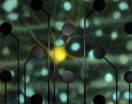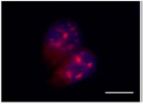(Press-News.org) The calorie-burning triggered by cold temperatures can be achieved biochemically – without the chill – raising hopes for a weight-loss strategy focused on the immune system rather than the brain, according to a new study by UC San Francisco researchers.
The team determined that two signaling molecules secreted by cells of the immune system trigger the conversion of fat-storing white fat cells to fat-burning beige fat cells. Ajay Chawla, MD, PhD, an associate professor of medicine at the UCSF Cardiovascular Research Institute, led the study, published online June 5, 2014 in the journal Cell.
Working with mice, Chawla's team discovered that the signaling molecules, called interleukin 4 and interleukin 13, activate cells known as macrophages, which in turn drive the fat conversion. In one experiment the researchers gave interleukin 4 to mice, which increased beige fat mass, leading to weight loss.
The finding builds on previous work by Chawla's team, which reported in 2011 in Nature that cold activates part of the immune system, and specifically activates interleukin 4 in fat. In the new study, Chawla's team determined that both interleukin 4 and interleukin 13 recruit macrophages to fat and that the production of molecules called catecholamines by the macrophages causes the browning of white fat.
When the researchers inhibited interleukin 4 signaling in white fat, they found that the mice made less beige fat, burned less energy, and could no longer maintain normal body temperature in the cold.
The study results are likely to further fuel the quest to identify new ways to pharmaceutically tame obesity by targeting how much energy we burn, not just how many calories we ingest, according to Chawla.
"If you could increase energy expenditure by even a few percent, over a period of a year or two year you would make a big difference," he said.
The new discovery is surprising, Chawla said, because it makes it clear that this control mechanism for fat burning bypasses components of the autonomic nervous system that govern many physiological adaptations. "Nutrient and energy metabolism has largely been thought to be under the control of the brain and endocrine system," he said.
In comparison to the nervous system, the immune pathway might be more easily manipulated to increase energy expenditure, Chawla said. In fact, another study published simultaneously in Cell by researchers from the Dana-Farber Cancer Institute and Harvard Medical School reports the identification of a hormone, produced in fat tissue after cold exposure, that activates interleukin 4 and interleukin 13 to drive fat burning.
Humans and other mammals shiver to keep warm, but cold also triggers the growth of fat cells that burn fuel, instead of the fat cells that store it. Keep humans indoors at 61 degrees to 63 degrees Fahrenheit without allowing them to bundle up, and they lose weight, research shows. That's because they adapt by generating more fat-burning cells to help them keep warm.
In contrast to the power-converting mechanisms in white fat cells, the gears in the power plants within fat-burning fat cells spin inefficiently. This causes them to burn more energy and generate heat. The trigger for this accelerated fat burning is the activation within the cell's power plants – called mitochondria – of a protein called uncoupling protein 1 (UCP1). Cells with UCP1 are capable of heat generation and fat burning, and are known as brown fat or beige fat, depending on the tissue from which they originate. They have more mitochondria than white cells and therefore have a darker tinge.
In comparison to other mammals, ranging in size from mice to bears, until a few years ago it was widely thought that humans had little brown or beige fat and little potential to generate it.
Although Chawla and many other researchers now believe that the potential to exploit brown fat for weight loss is significant, the amount of individual variation when it comes to brown fat reserves and the potential to generate more brown fat is unclear. "We don't know what the dynamic range is," Chawla said. "It appears that women have less, that we have less as we age, and that obesity is associated with having less brown fat."
INFORMATION:
Additional UCSF study authors include postdoctoral fellows Yifu Qiu, PhD, Khoa Nguyen, PhD, and Justin Odegaard, MD, PhD; and Richard Locksley, MD, a professor of medicine and Howard Hughes Medical Institute investigator. Richard Palmiter, PhD, professor of biochemistry and Howard Hughes Medical Institute investigator at the University of Washington, also is a co-author of the study. The research was funded by the National Institutes of Health and the American Heart Association.
UC San Francisco (UCSF), now celebrating the 150th anniversary of its founding, is a leading university dedicated to promoting health worldwide through advanced biomedical research, graduate-level education in the life sciences and health professions, and excellence in patient care. It includes top-ranked graduate schools of dentistry, medicine, nursing and pharmacy, a graduate division with nationally renowned programs in basic, biomedical, translational and population sciences, as well as a preeminent biomedical research enterprise and two top-ranked hospitals, UCSF Medical Center and UCSF Benioff Children's Hospital San Francisco. Please visit http://www.ucsf.edu.
Immune system molecules may promote weight loss, UCSF study finds
2014-06-05
ELSE PRESS RELEASES FROM THIS DATE:
Scientists generate long-sought molecular map of critical genetic machinery
2014-06-05
LA JOLLA, CA—June 5, 2014—A team led by researchers at The Scripps Research Institute (TSRI) has used advanced electron microscopy techniques to determine the first accurate structural map of Mediator, one of the largest and most complex "molecular machines" in cells.
Mediator is crucial for the regulation of most genes' activity and works in the cells of all plants and animals. The mapping of its structure—which includes more than two dozen unique protein subunits—represents a significant advance in basic cell biology and should shed light on medical conditions involving ...
Diabetes care depends on how your doctor is paid
2014-06-05
TORONTO, June 5, 2014 – From 2006 to 2008, nearly 75 per cent of Ontarians with diabetes did not receive all of the tests recommended to properly monitor their disease. How their doctor was paid was one of the factors determining the care they received, according to a study by researchers at St. Michael's Hospital and the Institute for Clinical Evaluative Sciences (ICES).
The study, published today in the Canadian Journal of Diabetes, found that patients who were not actively enrolled with a family doctor were least likely to receive optimum diabetes care. The researchers ...
New method reveals single protein interaction key to embryonic stem cell differentiation
2014-06-05
Proteins are responsible for the vast majority of the cellular functions that shape life, but like guests at a crowded dinner party, they interact transiently and in complex networks, making it difficult to determine which specific interactions are most important.
Now, researchers from the University of Chicago have pioneered a new technique to simplify the study of protein networks and identify the importance of individual protein interactions. By designing synthetic proteins that can only interact with a pre-determined partner, and introducing them into cells, the team ...
Research helps clarify how obesity leads to type 2 diabetes, cancer
2014-06-05
New findings about the biological links between obesity, insulin resistance and type 2 diabetes may also shed light on the connection between obesity and cancer, says a scientist at The University of Texas at Dallas.
In a study published online June 5 in the journal Cell, UT Dallas' Dr. Jung-whan (Jay) Kim and colleagues at the University of California, San Diego found that a protein called HIF-1 alpha plays a key role in the development of insulin resistance and type 2 diabetes in obese mice.
The researchers genetically engineered mice to lack the HIF-1 alpha protein ...
New research explains how we use the GPS inside our brain to navigate
2014-06-05
The way we navigate from A to B is controlled by two brain regions which track the distance to our destination, according to new research funded by the Wellcome Trust and published in Current Biology.
The study found that at the beginning of a journey, one region of the brain calculates the straight-line to the destination ('the distance as a crow flies'), but during travel a different area of the brain computes the precise distance along the path to get there.
The findings pinpoint the precise brain regions used and in doing so change how scientists believed we use ...
Our own treacherous immune genes can cause cancer after viral infection
2014-06-05
HPV (human papillomavirus) infection is widely known to induce cancer. Many of the mutations that cause this virally-induced cancer are caused by a family of genes that normally combats viral infections, finds new UCL (University College London) research.
This raises the possibility of developing drugs to regulate the activity of these genes to prevent HPV-associated cancers from developing and reduce the ability of existing cancers to evolve resistance to treatments.
The research, published in Cell Reports, shows for the first time that genes from the 'APOBEC' family, ...
Cellular traffic control system mapped for the first time
2014-06-05
Cells must transport nutrients and messenger cargos through its membrane and transport them within the cell at the correct time and place. This procedure is complex and is regulated with the help of specific genes. If disturbances in the transport mechanism arise, severe diseases, such as diabetes, cancer and diverse neurological pathologies, are the consequence. The discovery of the molecular principles of cellular transport was honored with the Nobel Prize of physiology and medicine in 2013. While knowing the intracellular roads and the functioning of the cars that use ...
Unmasking viral invaders
2014-06-05
If you have it, you probably don't know it. Cytomegalovirus, or CMV, is perhaps one of the biggest pathogens you've never heard of—big, both proportionately and epidemiologically. It contains approximately 200 genes, compared to HIV's paltry 18, and it's everywhere. You can catch it as a preschooler salivating over blocks, or as a teenager experiencing your first kiss. Once you have it, you have it for life.
Good news: If you're healthy, it's harmless. Your T cells keep it in check, and you'll be none the wiser.
Bad news: If you have any medical condition that dampens ...
Making artificial vision look more natural
2014-06-05
In laboratory tests, researchers have used electrical stimulation of retinal cells to produce the same patterns of activity that occur when the retina sees a moving object. Although more work remains, this is a step toward restoring natural, high-fidelity vision to blind people, the researchers say. The work was funded in part by the National Institutes of Health.
Just 20 years ago, bionic vision was more a science fiction cliché than a realistic medical goal. But in the past few years, the first artificial vision technology has come on the market in the United States ...
Discovered a new way to control genetic material altered in cancer
2014-06-05
When we talk about genetic material, we are usually referring to the DNA (deoxyribonucleic acid) that we inherit from our parents. This DNA is the factory where is built a similar molecule called RNA (ribonucleic acid) which produces our proteins, such as hemoglobin or insulin , allowing the lives of our cells. But there is a special group called non-coding RNA that has a more enigmatic function.
The best known is microRNAs, tiny molecules that are responsible for turning on or off our genome like an electrical current switch. Today, an article published in the prestigious ...



